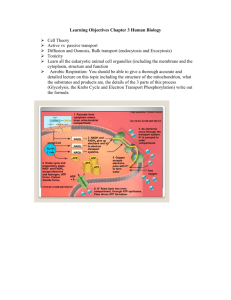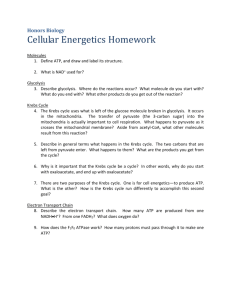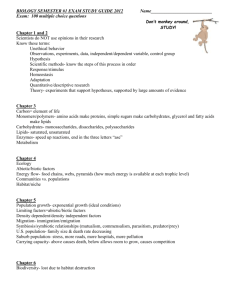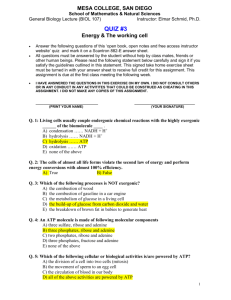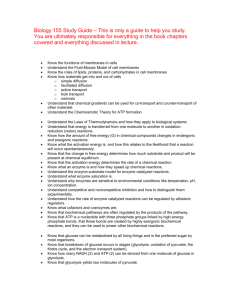Honors Biology - LangdonBiology.org
advertisement
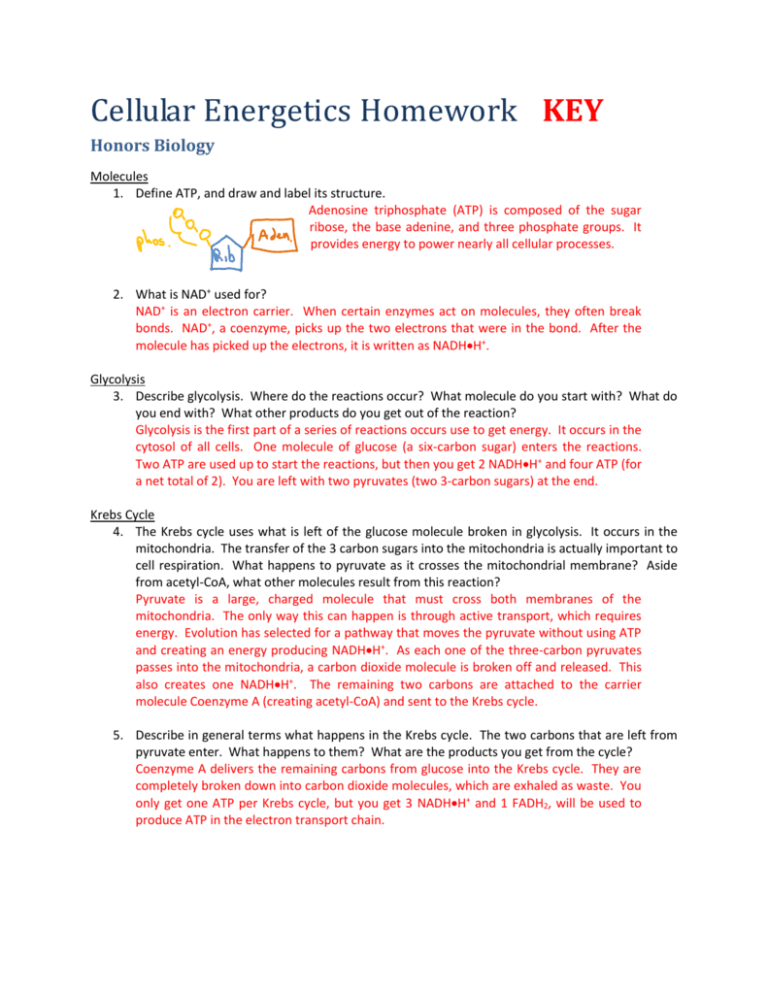
Cellular Energetics Homework KEY Honors Biology Molecules 1. Define ATP, and draw and label its structure. Adenosine triphosphate (ATP) is composed of the sugar ribose, the base adenine, and three phosphate groups. It provides energy to power nearly all cellular processes. 2. What is NAD+ used for? NAD+ is an electron carrier. When certain enzymes act on molecules, they often break bonds. NAD+, a coenzyme, picks up the two electrons that were in the bond. After the molecule has picked up the electrons, it is written as NADHH+. Glycolysis 3. Describe glycolysis. Where do the reactions occur? What molecule do you start with? What do you end with? What other products do you get out of the reaction? Glycolysis is the first part of a series of reactions occurs use to get energy. It occurs in the cytosol of all cells. One molecule of glucose (a six-carbon sugar) enters the reactions. Two ATP are used up to start the reactions, but then you get 2 NADHH+ and four ATP (for a net total of 2). You are left with two pyruvates (two 3-carbon sugars) at the end. Krebs Cycle 4. The Krebs cycle uses what is left of the glucose molecule broken in glycolysis. It occurs in the mitochondria. The transfer of the 3 carbon sugars into the mitochondria is actually important to cell respiration. What happens to pyruvate as it crosses the mitochondrial membrane? Aside from acetyl-CoA, what other molecules result from this reaction? Pyruvate is a large, charged molecule that must cross both membranes of the mitochondria. The only way this can happen is through active transport, which requires energy. Evolution has selected for a pathway that moves the pyruvate without using ATP and creating an energy producing NADHH+. As each one of the three-carbon pyruvates passes into the mitochondria, a carbon dioxide molecule is broken off and released. This also creates one NADHH+. The remaining two carbons are attached to the carrier molecule Coenzyme A (creating acetyl-CoA) and sent to the Krebs cycle. 5. Describe in general terms what happens in the Krebs cycle. The two carbons that are left from pyruvate enter. What happens to them? What are the products you get from the cycle? Coenzyme A delivers the remaining carbons from glucose into the Krebs cycle. They are completely broken down into carbon dioxide molecules, which are exhaled as waste. You only get one ATP per Krebs cycle, but you get 3 NADHH+ and 1 FADH2, will be used to produce ATP in the electron transport chain. 6. Why is it important that the Krebs cycle be a cycle? In other words, why do you start with oxaloacetate, and end up with oxaloacetate? Cycles save energy and resources. By ending with the material you started with, you don’t waste ATP and biomolecules to remake it to start the reaction again. 7. There are two purposes of the Krebs cycle. One is for cell energetics—to produce ATP. What is the other? How is the Krebs cycle run differently to accomplish this second goal? The Kreb cycle can proceed as a complete cycle, to completely break down glucose into carbon dioxide and to harvest the electrons for energy. It can also be run to produce raw materials for building any of the many biomolecules needed by the cell. When this happens, the cycle stops when the needed molecule is taken away. The cell must then spend energy and resources to build an oxaloacetate to restart the cycle. This costs energy and material. Electron Transport Chain 8. Describe the electron transport chain. How many ATP are produced from one NADHH+? From one FADH2? What does oxygen do? The electron transport chain is composed of three integral protein pumps that pump protons from the matrix into the space in between the inner and outer membrane of the mitochondria. These pumps are powered by moving electrons, delivered either by NADHH+ or FADH2. NADHH+ delivers electrons to the first pump, and creates enough energy to produce 3 ATP. FADH2 delivers electrons to the second pump, and can produce 2 ATP. The electrons travel from proton pump to proton pump, eventually ending up at the last pump. From here, oxygen picks up these electrons, and becomes water. Without oxygen, the electrons cannot leave the last pump, shutting down the flow and stopping the reaction. 9. How does the F1F0 ATPase work? How many protons must pass through it to make one ATP? The ATPase is a facilitated diffusion transport protein that allows the protons to diffuse from the intermembrane space. For ever two protons that diffuse back into the mitochondria, one ATP is made. 10. You have discovered life on Mars. You become instantly world famous and insanely rich. You perform some fundamental biochemical research on this life, and discover it has a different cellular respiration process than life on Earth. This earns you the Nobel Prize and the deep respect of your scientific peers. You die incredibly successful, rich, and fulfilled. The Martian’s respiration cycle produces the following molecules: 46 NADHH+, 14 FADH2 Its ATPase needs three protons to pass through in order to make one ATP. How many ATP will it make, assuming that everything else works the same as terrestrial life? 46 NADHH+ • 6 protons • 1 ATP = 92 ATP 1 NADHH+ 3 protons 14 FADH2 • 4 protons • 1 ATP = 18.67 ATP = 110 ATP total 1 FADH2 3 protons 11. The miniature candy bars you get on Halloween contain about 2.3 x 1022 (23 000 000 000 000 000 000 000) glucose molecules. How many ATP would you get from eating just one? 2.3 x 1022 glucose 38 ATP = 8.7 x 1023 ATP 1 glucose 12. A chemical reaction creates 7 NADHH+. How many ATP will this produce? 7 NADHH+ 3 ATP = 21 ATP 1 NADHH+ You get 17 FADHH+ from a different reaction. How many ATP would this create? 17 FADH2 2 ATP = 34 ATP 1 FADH2 Fermentation 13. What is fermentation? What are two chemicals produced by fermentation? Which one is created by humans? Fermentation is a series of chemical reactions that allow cells to get a small amount of ATP without oxygen. It regenerates NAD+ by adding the electrons carried by NADHH+ to pyruvate, permitting a cell to carry out glycolysis, getting 2 ATP per molecule of glucose. Some bacteria and fungi produce ethyl alcohol (drinking alcohol) as a product of fermentation. Other life forms, like humans, produce lactic acid. 14. Why does your body perform fermentation when there is no oxygen present? In order for glycolysis to occur, you must have NAD+ available to convert glucose into two pyruvates, and thus make 2 ATP. If you have no NAD+, because it has all been converted into NADHH+, then no glycolysis and not ATP. In fermentation, enzymes use the NADHH+ to convert pyruvate into other molecules (like alcohol and lactic acid), restoring NAD+ so that glycolysis and its limited yield of ATP can continue. 15. If someone dies from suffocation, the medical examiner can often determine this by examining the pH of the blood. Blood pH is normally about 7.4, slightly basic. After someone is deprived of oxygen for long periods, their blood becomes acidic, a medical condition called acidosis. This occurs for two reasons: First, CO2 builds up the blood. When CO2 dissolves in water, it forms an acid called carbonic acid. What is the second reason? Think fermentation… Lactic acid builds up in the blood. It is, by name, an acid and lowers the pH. Photosynthesis 16. Give the balanced chemical formula for photosynthesis. How is it related to cellular respiration? The formula is 6CO2 + 6H2O → C6H12O6 + 6O2. It is the reverse of the balanced equation for cellular respiration. 17. What is the purpose of the light reactions? The Calvin Cycle (dark reactions)? The light reactions recharge ADP into ATP and yield electrons in the form of NADPH•H +. The Calvin cycle creates glucose by fixing carbon dioxide from the atmosphere. The Calvin cycle requires large amounts of ATP and NADPH•H+. Light Reactions 18. Compare the light reactions of photosynthesis to the electron transport chain in mitochondria. Think about where they are located, what parts they share, and what parts are different. Both are in a membrane, both have proton pumps, and both produce ATP. The electron transport chain in mitochondria has three pumps, the chloroplast has one. The ETC uses NAD, and the chloroplast uses NADP. The chloroplast uses chlorophyll and the ETC does not. 19. PSII (photosystem II) requires light and water to function. Describe what each is used for. Light strikes the magnesium in the chlorophyll, knocking out two electrons. [These electrons then travel through the proton pump and are eventually taken away by NADPH•H+]. PSII then reacts with water, taking electrons to restore chlorophyll. With the electrons gone, water breaks down into oxygen and protons. Dark Reactions 20. The role of the dark reaction is to create glucose. Why do plants, who receive so much energy from the light reactions, need glucose? Plants have huge amounts of ATP during the day due to photosynthesis. But at night or when the weather is cloudy, they need another source of ATP. They respire the glucose for energy. Just as important, since the plants do not eat, they use the glucose they make to serve as the building blocks for all of the biomolecules used by the cell. 21. The dark reactions require three chemicals to create glucose. Provide them. The dark reactions require six carbon dioxide to make one glucose. They also need many ATP to power the reaction, and many electrons from NADPH•H+ to form the new molecule. This question is optional, and will not be graded. For serious students who want to think a little more deeply: 22. When a glucose molecule is broken down in the mitochondria of plants, 36 ATP are produced. When a glucose molecule is created in photosynthesis, it takes the equivalent of over 50 ATP to create. Why is it so much more expensive to make glucose? Recall that one of the laws of thermodynamics says that all things go from high concentration to low concentrations. The only way to violate this law is to expend energy. To get energy from glucose, one glucose molecule is broken into 6 carbon dioxides, from 1 tightly combined molecule into six smaller molecules that can spread out. This obeys the law of thermodynamics. Photosynthesis does the opposite, taking six small carbon dioxide molecules and forcing them into one highly organized, concentrated glucose. This violates the law of thermodynamics; the only way you can do this is to use energy. This is way photosynthesis costs more than respiration.
